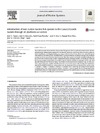Identificador persistente para citar o vincular este elemento:
https://accedacris.ulpgc.es/jspui/handle/10553/72808
| Título: | Oil platforms as introduction vector of non-native marine fish species to the Canary Islands waters (central-eastern Atlantic) | Autores/as: | Triay Portella, Raül González Pajuelo, José Mario González Pérez, José Antonio Martín García, Jose Antonio Ruiz-Díaz, Raquel Lorenzo Nespereira, José María Luque Escalona, Ángel |
Clasificación UNESCO: | 240114-4 Taxonomía animal. Peces 310510 Dinámica de las poblaciones |
Palabras clave: | Alien species Non indigenous species Oil rigs Input vector Canary Islands |
Fecha de publicación: | 2016 | Publicación seriada: | Frontiers in Marine Science | Conferencia: | XIX Iberian Symposium on Marine Biology Studies (SIEBM 2016) | Resumen: | This work documents the introduction of non-native fish species to the Canary Islands (central-eastern Atlantic) through oil rigs. Methodological approaches have included surveys by underwater visual censuses around and under oil platforms and along the docking area of rigs at the Port of Las Palmas. Eleven non-native fish species were registered. Paranthias furcifer, Abudefduf hoefleri, Acanthurus bahianus, Acanthurus chirurgus, and Acanthurus coeruleus are first recorded from the Canaries herein. Other three species could not be identified, although they have never been observed in the Canaries. Cephalopholis taeniops, Abudefduf saxatilis, and Acanthurus monroviae had been previously recorded. Native areas of these species coincide with the areas of origin and the scale of oil rigs with destination the Port of Las Palmas. The absence of native species in the censuses at rigs and their presence at rigs docking area, together with the observation of non-native species after the departure of platforms, reject the possibility that these non-native species were already present in the area introduced by another vector. C. taeniops, A. hoefleri, A. saxatilis, A. chirurgus, A. coeruleus and A. monroviae are clearly seafarer species. A. bahianus seems to be a potential seafarer species. P. furcifer is a castaway species. For themoment, the number of individuals of the non-native species in marine ecosystems of the Canaries seems to be low, and more investigation is needed for controlling these translocations. | URI: | https://accedacris.ulpgc.es/handle/10553/72808 | ISSN: | 2296-7745 | DOI: | 10.3389/conf.FMARS.2016.05.00020 | Fuente: | Frontiers in marine science [ISSN 2296-7745], Conference Abstract: XIX Iberian Symposium on Marine Biology Studies |
| Colección: | Actas de congresos |
Visitas
206
actualizado el 07-dic-2024
Descargas
401
actualizado el 07-dic-2024
Google ScholarTM
Verifica
Altmetric
Comparte
Exporta metadatos
Los elementos en ULPGC accedaCRIS están protegidos por derechos de autor con todos los derechos reservados, a menos que se indique lo contrario.
